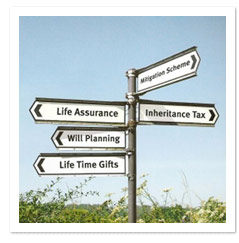Inheritance Tax Planning | A Case Study

Introduction
I hope this case study will begin to paint a picture for the reader of what financial planning really is all about. I am using an actual Client to show how the threads of Inheritance Tax mitigation planning, outlined elsewhere on this site, can be drawn together to create a bespoke, comprehensive plan. To fully understand the planning put in place within this case study, the reader should also familiarise themselves with the other articles in this section of my website, but, in particular, – Business Relief (BR), and Habitual Expenditure out of Normal Income.
The scenario
I’ll call this lady Enid, and describe her financial situation following the recent death of her husband, Claude.
Enid is aged 70 and is in good health; other than a couple of successful cataract operations recently and childbirth several decades ago, she has hardly troubled the medical profession. Following Claude’s death, her net pension income, from the Civil Service and the State, is in the order of £2,000 per calendar month and, of course, index-linked. Despite the wealth that Enid and Claude acquired during their lives together, both from savings and inheritances received, they had a fairly modest lifestyle, which is unlikely to change significantly. Consequently, Enid will manage quite comfortably on her pension income, so the £15,000 per annum of net income generated by her investments will be largely surplus to requirements.
Following the administration of Claude’s estate, Enid’s assets (she has no liabilities), ignoring furniture and effects, etc, amount to:
| Home, say | £ 800,000 |
| Investments | £ 724,000 |
| Existing IHT Plan | £ 73,000 |
| Cash savings | £ 113,000 |
| £1,710,000 |
Whilst Enid’s overriding concern is to maintain her own financial independence, come what may, she continues to be concerned about the impact Inheritance Tax (IHT) will have on her two sons when they eventually inherit. This had been a subject of discussion over a number of years, hence the existing IHT plan above. Also, Claude had an IHT-efficient element to his portfolio, comprising Alternative Investment Market (AIM) shares qualifying for Business Relief (BR). This portfolio was bequeathed to his sons under the terms of his Will. However, having owned the shares for considerably more than 2-years, the bequest, which gave both sons an inheritance of over £70,000 each, didn’t use any of Claude’s Nil Rate Band (NRB).
Claude and Enid were keen to help their sons during their lifetimes, rather than to leave everything by way of an inheritance on the second death. Consequently, prior to his death, Claude had drawn his pension benefits and, at that time – July 2011 – Enid had given both sons £100,000, mainly funded from her earlier inheritance from her father. These were Potentially Exempt Transfers (PETs), meaning there were no immediate IHT issues, but the gifts would be added back to the taxable estate if Enid was to die within 7-years.
Based on the figures outlined above, and current legislation, the potential IHT liability on Enid’s subsequent death (assuming it was after July 2018) will be in the order of £394,800, as follows:
| Assets as above | £1,710,000 |
| Less: IHT plan | £ 73,000 |
| £1,637,000 | |
| Less: 2 x NRB | £ 650,000 |
| Taxable estate | £ 987,000 |
| Tax @ 40% | £ 394,800 |
The existing IHT Plan held by Enid is valued at nil for IHT purposes, as it qualifies for Business Relief, having been held for more than 2-years and being invested in qualifying business assets. At the time, the NRB was £325,000 and the Residence Nil Rate Band hadn’t been introduced, but as Claude used none of this upon his death, two NRBs will be available to Enid upon her subsequent death.
The analysis
Using the sophisticated cash-flow modelling software available to me, I established that £100,000 from savings and investments and £8,000 per annum of net income was available for IHT planning without impacting Enid’s current or future lifestyle.
The following parameters were used in the cash-flow modelling:
- That Enid has a life expectancy of 20-years (Source: National Statistics April 2014)
- Income would increase at 2½% per annum on average.
- Expenditure would increase at 3% per annum on average.
- For the last 4-years of Enid’s life she would need 24-hour a day carers, costing £2,000 per week in 2014 terms.
- During those last 4-years, expenditure would then increase at 5% per annum on average.
Two scenarios were then run, excluding all of the cash savings, and, firstly, assuming that investments didn’t grow at all and, secondly, that investments grew at 5% per annum on average net of taxes and charges.
The plan
The question then was, “What to do with the £100,000, the £8,000 of income and the other assets to maximise the IHT saving”.
In summary, the recommendations were as follows:
- Continuing the policy of helping her sons now, Enid wanted to make another gift – a PET – of £50,000 each.
- Using the normal, habitual expenditure out of income exemption, take out a guaranteed Whole of Life Policy, with a premium of £8,000 per annum, and assign that to a family Trust in favour of her sons, and any future grandchildren.
- Reorganise her investment portfolio, so that the growth element was invested in AIM shares, which would benefit from BR after 2-years.
The outcome
Starting with a potential IHT liability of £394,800, the impact of this planning would be:
| IHT at outset | £394,800 | |
| PET of £100,000 | £ 40,000 | Saving after 7-years |
| £354,800 | ||
| Whole of Life (cover £230,000) | £230,000 | Tax-free upon death |
| £124,800 | ||
| AIM Portfolio (£240,650) | £ 96,260 | Saving after 2-years |
| IHT at conclusion | £ 28,540 |
So, a saving of £366,260 in IHT, a near 93% reduction, in exchange for £100,000 and £8,000 per annum of surplus income.
Strictly speaking, in Enid’s circumstances, the tax-savings were marginally less than stated here, because there was some £2,000 in Capital Gains Tax to pay following the portfolio reorganisation.
The detail
IHT Planning
The PET is actually only £97,000, because Enid hasn’t used her Annual Gift Allowance of £3,000 this year. The funds came from investments sold within Claude’s estate and transferred to Enid by the Executors.
Readers with some knowledge of IHT planning may ask why a Deed of Variation (DoV) wasn’t used. A DoV is a means of effectively re-writing someone’s Will post mortem, which, if it is completed within 2-years of death, is effective for IHT purposes. In this scenario, the DoV would have given £100,000 to the sons directly from Claude’s Will, using some of his NRB. In turn this would then reduce the amount of the double NRB available on Enid’s subsequent death to some 169% of the then NRB rather than 200%. The NRB was set at £325,000 in April 2009, remains unchanged in 2023/24 and is scheduled to remain the same until 2028. With that background, and Enid’s realistic life-expectancy of 20-years, 200% of the then NRB looks much more attractive than just 169%.
The level of cover for the Whole of Life policy was established solely by reference to affordability; a premium of £8,000 per annum (actually £8,000.99) provided £230,000 of cover, with acceptance on the provider’s standard, non-smoker terms.
The amount allocated to the AIM Portfolio was arrived at via a thorough understanding of Enid’s attitude to investment risk and tolerance for loss, coupled with an analysis of the likely risk profile of a new portfolio comprising some AIM shares and a balance in lower risk, defensive investments.
Investment Risk
I have been giving investment advice to Enid (and Claude) since August 2005 and her attitude to investment risk has always been what I would now describe as “balanced” and would define as:
“A balanced risk investor is looking for a balance of risk and reward, seeking higher returns than those available from a high street deposit account and willing to accept a moderate amount of fluctuation in the value of their investments as a result. However, they would feel uncomfortable if their investments were to fall by more than 15% in one year”.
The first stage in setting-up a new portfolio was to research the marketplace and decide upon a Discretionary Fund Manager (DFM) with whom we could partner and who could provide both the AIM and low risk elements required for the new portfolio. Subsequently, I debated with the DFM how we could achieve Enid’s objective without materially altering this overall risk profile of the portfolio.
From this discussion we settled on a 45/55% split between AIM and the lower risk elements. I found the DFM to be overly optimistic in so far as, using this split, they considered the downside risk would be as low as -11.3%, which is well within our target range for a “moderate” Investor of up to -15%. However, the DFM was not managing an exclusively AIM (UK smaller companies) portfolio at the beginning of the recent recession. Consequently, I believed it was better to look at some longer-term statistics and consider what the worst case scenario could be, so that Enid entered into this phase of her financial planning with her eyes wide open.
I had first introduced AIM investment to Claude in May 2005 when, as Attorney for his Mother, he was keen to try and save some IHT on her eventual death. Consequently, upon my recommendation, we converted her portfolio of largely FTSE100 Index shares into an AIM portfolio; an investment of some £65,000 in total. Unfortunately, Claude’s mother died on 01 July 2007 just weeks before achieving the 2-year qualification for BR!
Claude decided to retain the AIM portfolio and it was this portfolio that provided his sons with some £70,000 each around 7-years later.
With this indirect experience of AIM investment, being a long-term investor and having a strong desire to achieve the IHT savings available, Enid was happy to proceed on the 45/55% basis. She understood that whilst the DFM was going to strive to keep the downside risk as low as possible, this could well exceed her normal tolerance level in extreme market conditions.
Investment Income
The income from the AIM portfolio was estimated by the DFM to be some £5,000 per annum and it was agreed that this would be accumulated to meet some of the management, administration and advice expenses, reducing the impact on the tax-efficient capital. Incidentally, Enid’s existing ISAs and her future ISA Allowances were also going to be utilised within the AIM portfolio, particularly with an eye towards future tax-free capital gains.
The income from the low risk portfolio was estimated by the DFM to be some £10,000 per annum and this was going to be paid out to Enid to both supplement her pensions and provide the £8,000 needed for the life assurance premiums.
Addendum – 2017
Readers with some knowledge of IHT planning will be wondering what impact the Residential Nil Rate Band (RNRB) is going to have on this planning, but my view is very little. Enid’s estate, with continuing house price inflation in South East London and the growth in her investments, is now in excess of £2m (whilst the AIM Portfolio is now IHT-free, it’s value is included in the RNRB calculation) . At this point, the RNRB starts to reduce at the rate of £1 of the band for every £2 over £2m.
In any event, Enid’s standard of living or access to the vast majority of her savings and investments hasn’t been impaired and her Sons will receive their full inheritance in due course. So, even if these elements of the original plan are no longer strictly necessary for IHT mitigation, the “baby hasn’t been thrown out with the bath water”.
What next?
If you believe you have an Inheritance Tax problem and want to know what legitimate steps you can take to mitigate this, contact me today, or complete the form below.







-

-

-

0800 074 8755info@clivebarwell.co.uk